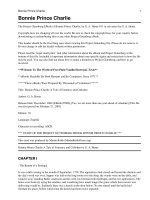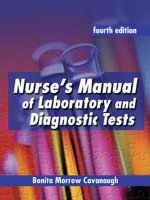2015 a manual of laboratory and diagnostic tests 9th ed PDF www medicalbr tk
Bạn đang xem bản rút gọn của tài liệu. Xem và tải ngay bản đầy đủ của tài liệu tại đây (15.98 MB, 1,282 trang )
Get more medical books and resources at
www.medicalbr.tk
Frontmatter Title
A
MANUAL
i
OF
Laboratory and
Diagnostic Tests
NINTH EDITION
Fischbach_FM_printer_file.indd i
11/4/13 10:43 PM
Fischbach_FM_printer_file.indd ii
11/4/13 10:43 PM
A
MANUAL
OF
Laboratory and
Diagnostic Tests
NINTH EDITION
Frances Talaska Fischbach, RN, BSN, MSN
Associate Clinical Professor of Nursing
School of Nursing
University of Wisconsin-Milwaukee
Milwaukee, Wisconsin
Associate Professor of Nursing (Ret)
School of Nursing
University of Wisconsin-Milwaukee
Milwaukee, Wisconsin
Marshall Barnett Dunning III, BS, MS, PhD
Professor of Medicine & Physiology
Department of Medicine
Division of Pulmonary/Critical Care Medicine
Medical College of Wisconsin
Milwaukee, Wisconsin
Fischbach_FM_printer_file.indd iii
11/4/13 10:43 PM
Acquisitions Editor: Patrick Barbera
Managing Editor: Roxanne Halpine Ward
Design Coordinator: Holly McLaughlin
Art Director, Illustration: Jennifer Clements
Production Project Manager: Cynthia Rudy
Manufacturing Coordinator: Karin Duffield
Prepress Vendor: Absolute Service, Inc.
9th Edition
Copyright © 2015 Wolters Kluwer Health | Lippincott Williams & Wilkins.
Copyright © 2009 Wolters Kluwer Health | Lippincott Williams & Wilkins. Copyright © 2004, 2000 by
Lippincott Williams & Wilkins. Copyright © 1996 by Lippincott-Raven Publishers. Copyright © 1992,
1988, 1984, 1980 by J. B. Lippincott Company. All rights reserved. This book is protected by copyright.
No part of this book may be reproduced or transmitted in any form or by any means, including as photocopies or scanned-in or other electronic copies, or utilized by any information storage and retrieval
system without written permission from the copyright owner, except for brief quotations embodied in
critical articles and reviews. Materials appearing in this book prepared by individuals as part of their
official duties as U.S. government employees are not covered by the above-mentioned copyright.
To request permission, please contact Lippincott Williams & Wilkins at Two Commerce Square,
2001 Market Street, Philadelphia, PA 19103, via email at , or via our website
at lww.com (products and services).
987654321
Printed in China
Library of Congress Cataloging-in-Publication Data
ISBN: 978-1-4511-9089-2
Cataloging-in-Publication Data available on request from the publisher.
Care has been taken to confirm the accuracy of the information presented and to describe generally
accepted practices. However, the authors, editors, and publisher are not responsible for errors or omissions or for any consequences from application of the information in this book and make no warranty,
expressed or implied, with respect to the currency, completeness, or accuracy of the contents of the
publication. Application of this information in a particular situation remains the professional responsibility of the practitioner; the clinical treatments described and recommended may not be considered
absolute and universal recommendations.
The authors, editors, and publisher have exerted every effort to ensure that drug selection and dosage
set forth in this text are in accordance with the current recommendations and practice at the time of
publication. However, in view of ongoing research, changes in government regulations, and the constant
flow of information relating to drug therapy and drug reactions, the reader is urged to check the package
insert for each drug for any change in indications and dosage and for added warnings and precautions.
This is particularly important when the recommended agent is a new or infrequently employed drug.
Some drugs and medical devices presented in this publication have Food and Drug Administration
(FDA) clearance for limited use in restricted research settings. It is the responsibility of the health care
provider to ascertain the FDA status of each drug or device planned for use in his or her clinical practice.
LWW.COM
Fischbach_FM_printer_file.indd iv
11/4/13 10:43 PM
To the memory of Marshall B. Dunning III
Dear friend and coauthor
1947–2013
Fischbach_FM_printer_file.indd v
11/4/13 10:43 PM
Contributors, Consultants, and Research Assistants
Margaret A. Fischbach, RN, BA, JD
Compliance Officer
Allay Home & Hospice, Inc.
Brookfield, Wisconsin
Mary Fischbach Johnson, BA, MS
Research Assistant
New York, New York
Patricia A. Van Kampen
Student Nurse
Research Assistant
Wausau, Wisconsin
Patti Cobb, RD, CD
Chief Clinical Dietitian
Food and Nutrition Services
Froedtert Hospital
Milwaukee, Wisconsin
Carol Colasacco, CT(ASCP), CMIAC
Cytotechnologist, Department of Pathology
Fletcher Allen Health Care
Burlington, Vermont
Faye Enriquez, RN, BSN, MSN
Associate Clinical Professor
School of Nursing
University of Wisconsin
Milwaukee, Wisconsin
Ann Shafranski Fischbach, RN, CAOHC,
CPID
Case Manager
Restore Wheaton Franciscan Health Care
Milwaukee, Wisconsin
Gary Hoffman
Manager, Laboratory for Newborn Screening
State of Wisconsin
Madison, Wisconsin
Paul J. Jannetto, PhD, MT(ASCP), DABCC
Associate Professor, Pathology
Director, Clinical Chemistry/Toxicology
Medical College of Wisconsin
Milwaukee, Wisconsin
Jennifer Johnson RN, BSN
Cardiothoracic Procurement Coordinator
Loyola University Medical Center
Maywood, Illinois
Karen Kehl, PhD
Associate Professor-Pathology
Children’s Hospital of Wisconsin
Milwaukee, Wisconsin
Stanley F. Lo, PhD, DABCC, FACB
Associate Professor, Pathology
Associate Director, Clinical Laboratories
Technical Director, Clinical Chemistry, Point
of Care, and Biochemical Genetics
Directory, Reference Standards Laboratory
Children’s Hospital of Wisconsin
Medical College of Wisconsin
Milwaukee, Wisconsin
Charles R. Myers, PhD
Professor of Pharmacology and Toxicology
Medical College of Wisconsin
Milwaukee, Wisconsin
Christine Naczek, MT(ASCP)
Manager, Blood Banking and Pre-Transfusion
Testing
Department of Pathology
United Regional Medical Services, Inc.
Milwaukee, Wisconsin
Anne Witkowiak Nezworski, RN, BSN
Maternity and Newborn Specialist
Marshfield Clinic, Eau Claire Center
Eau Claire, Wisconsin
vi
Fischbach_FM_printer_file.indd vi
11/4/13 10:43 PM
Contributors, Consultants, and Research Assistants
Joseph Nezworski, ES, RN, BSN
Chief Deputy Medical Examiner
Eau Claire County
Nursing Supervisor
Sacred Heart Hospital
Eau Claire, Wisconsin
Rochelle Olive-Harmon, MS RT (R)
Program Director
School of Radiologic Technology
Froedtert Hospital
Medical College of Wisconsin
Milwaukee, Wisconsin
Hershel Raff, PhD
Department of Endocrinology
Medical College of Wisconsin
St. Luke’s Medical Center
Milwaukee, Wisconsin
Tracy A. Schweitzer, PhD, RN, BSN, MA
Clinical Assistant Professor
Marquette University
Milwaukee, Wisconsin
John Shalkham, MA, SCT(ASCP)
Program Director for School of Cytotechnology
State Laboratory of Hygiene
Clinical Assistant Professor
Department of Pathology
University of Wisconsin
Madison, Wisconsin
Jean M. Trione, RPh
Clinical Specialist
Wausau Hospital
Wausau, Wisconsin
Patti Wilson BSN, RN, CIC
Infection Control Coordinator
Froedtert Hospital
Milwaukee, Wisconsin
Michael Zacharisen, MD
Professor of Pediatrics
Children’s Hospital of Wisconsin
Milwaukee, Wisconsin
Reviewers
Sheryl F. Banak, MSN, RN, CNE
Faculty RN Program
Baptist Health Schools Little Rock
Little Rock, Arkansas
Simone Bollaerts, BN, RN, IIWCC
Professor in Nursing
Mohawk College of Applied Arts and
Technology
Hamilton, Ontario, Canada
Susan Weber Buchholz, PhD, RN
Professor
Rush University College of Nursing
Chicago, Illinois
Frank G. Steffel, BS, CNMT
Program Director–Nuclear Medicine/PET
Technology
Froedtert Hospital
Milwaukee, Wisconsin
Susan K. Callen, MSN, RN, CNE
Nursing Instructor II
UPMC Shadyside School of Nursing
Pittsburgh, Pennsylvania
Corrinne Strandell, RN, BSN, MSN, PhD
Nursing Research, Home Care and
Rehabilitation Specialist
West Allis, Wisconsin
Sandi Casey MS, RNC-MNN
Nursing Instructor
Connors State College
Muskogee, Oklahoma
Thudung Tieu, MT(ASCP)
Quality Assurance & Safety Manager
Dynacare Laboratories
Milwaukee, Wisconsin
Karen Chandra, MSN, MBA, RN
Associate Professor of Nursing
Harper College
Palatine, Illinois
Fischbach_FM_printer_file.indd vii
vii
11/4/13 10:43 PM
viii
Reviewers
Christine M. Cunningham, MS, MT
(ASCP)
Associate Professor
New York Chiropractic College
Seneca Falls, New York
Pasquale Fiore, RN, BScN, MSc, Health
Adm, Cert Ed
Nurse Educator
Camosun College
University of Victoria
Victoria, British Columbia, Canada
Paula Green, MSN
Assistant Professor
Nursing & Allied Sciences
Bronx Community College - CUNY
Bronx, New York
Nancy E. Pea, MSN, RN
Associate Professor
St. Louis Community College
Ferguson, Missouri
Carswella Phillips, DNP, MSN, ARNP
Assistant Professor
Florida Agricultural and Mechanical University,
School of Nursing
Tallahassee, Florida
Vanessa Pomarico-Denino, MSN, APRN,
FNP-BC
Interim Director and Lead Faculty Family
Nurse Practitioner Track
Southern Connecticut State University
New Haven, Connecticut
Cathy R. Kessenich, DSN, ARNP, FAANP
Professor of Nursing
University of Tampa
Tampa, Florida
Charlene Strumpel, MSN, RN
Instructor
University of British Columbia, Okanagan
Campus
Kelowna, British Columbia, Canada
Julie A. Koch, DNP, RN, FNP-BC
Assistant Professor and Coordinator of the FNP
Program
Valparaiso University College of Nursing
Valparaiso, Indiana
Angela Trott, MSN-Ed, BSN, RN
Associate Degree Nursing Instructor
Coastal Carolina Community College
Jacksonville, North Carolina
Diane M. Lew-Snide, PhD, RN
Professor of Nursing
Columbia-Greene Community College
Hudson, New York
Catherine Mbewe, MS, RN
Assistant Professor
Nursing and Allied Health Sciences
Bronx Community College - CUNY
Bronx, New York
S. Wendy Whillans, MScN, RN
Faculty, School of Nursing
Canadore College
North Bay, Ontario, Canada
Mary Ellen Wilkosz, PhD, MSN, BSN, RN,
FNP-BC
Associate Professor and Assistant Director FNP
Program
Sonoma State University
Rohnert Park, California
Janet O’Connell, MA Ed, BN
Professor of Nursing
Ryerson University, Centennial College,
George Brown College Collaborative BScN
Program
Toronto, Ontario, Canada
Fischbach_FM_printer_file.indd viii
11/4/13 10:43 PM
Frontmatter Title
ix
Preface
PURPOSE
The purpose of A Manual of Laboratory and Diagnostic Tests, in this ninth edition, is to promote the
delivery of safe, effective, and informed care for patients undergoing diagnostic tests and procedures
and also to provide clinicians and students, educators and researchers, and others with a unique
resource. This comprehensive manual provides a foundation for understanding diagnostic tests, from
the relatively simple to the most complex, that are delivered to varied populations in varied settings.
It describes in depth the clinician’s role in providing effective diagnostic services by providing the
information necessary for quality care planning, individualized patient assessment, analysis of patient
needs, appropriate interventions, patient education, patient follow-up, and timely outcome evaluation.
Potential risks and complications of diagnostic testing mandate that proper test protocols, interfering factors, follow-up testing, and collaboration among those involved in the testing process be a
significant part of the information included in this text.
ORGANIZATION
This book is organized into 16 chapters and 5 appendices. Chapter 1 outlines the clinician’s role in
diagnostic testing and includes interventions for safe, effective, informed pre-, intra-, and post-test
care. This chapter includes a Patient’s Bill of Rights and Responsibilities, a model for the role of the
clinical team in providing diagnostic care and services, descriptions of different test environments, and
discussion of reimbursement for diagnostic services, and emphasizes the importance of communication
as key to desired outcomes. The intratest section includes information about collaborative approaches
facilitating family presence during invasive procedures; risk management; the collection, handling, and
transport of specimens; infection control; controlling pain; comfort measures; administration of drugs
and solutions; monitoring fluid intake and loss; using required equipment kits and supplies; properly
positioning the patient for the procedure; managing the environment; and patient monitoring. The
reader is referred back to Chapter 1, Diagnostic Testing, throughout the text for information about the
clinician’s role and diagnostic services. Chapters 2 through 16 focus on specific categories of studies.
CHAPTER CONTENT AND FEATURES
Studies are organized in a similar way for ease of use and include:
Introductory Information
•
•
•
•
•
•
Background rationale
Test purpose
Interfering factors
Description and method of the procedure and lab test completion
Evidence-based outcomes
Patient involvement
ix
Fischbach_FM_printer_file.indd ix
11/4/13 10:43 PM
x
Preface
Reference Values
•
•
•
Normal reference values
Conventional and SI units
Age-related values and critical values when applicable
Procedures
•
•
•
Process of intratest care
Method of specimen collection and handling for lab tests
Method of diagnostic procedures
Clinical Implications
•
•
•
•
Interpretation of abnormal findings
Unexpected outcomes
Disease patterns
Clinical considerations for newborn, infant, child, adolescent, and older adult groups when
appropriate
Interventions
•
•
Pre- and post-test patient care
Specific guidelines for each test phase
Special Clinical Alerts
, Procedural Alerts
, and Notes NOTE appear frequently
throughout to signal special cautions.
A fully updated bibliography at the end of each chapter, representing a composite of selected references from various disciplines, directs the clinician to information available beyond the scope of this
book, and extensive appendices provide additional data for everyday practice.
REVISIONS AND ADDITIONS TO THE NINTH EDITION
The newest concepts and technologies are included in this edition:
•
•
•
•
•
•
Effects of drugs on lab outcomes
Guidelines for Pap screening
Guidelines for cancer screening
Bioterrorism agent testing
Pulmonary function testing
Mother-baby screening
All chapters have been reviewed by experts in the field. Current technologies have been incorporated throughout the text, maintaining emphasis on clinical and procedural alerts.
CURRENT DEVELOPMENTS IN LABORATORY AND DIAGNOSTIC
TESTING
New technologies foster new scientific modalities for patient assessment and clinical interventions. Thus,
the clinician is provided a greater understanding of the long chain of events from diagnosis through treatment and outcomes. In a brief span of years, new and improved technologies have led to developments
in x-ray scanners, digital and enhanced imaging, magnetic resonance (MR), positron emission tomography (PET) scans of the heart and brain, enhanced ultrasound and nuclear medicine procedures, newly
Fischbach_FM_printer_file.indd x
11/4/13 10:43 PM
Preface
xi
discovered genetic mutation studies, new cancer markers for diagnosis and prognosis, technology for fetal
testing before birth, and postmortem testing after death. Many new technologies are faster, more patient
friendly, more comfortable, and provide an equivalent or higher degree of accuracy (i.e., HIV or hepatitis
detection, monitoring for drug abuse or managing therapeutic drug levels). Saliva and breath testing is
gaining ground as a mirror of body function; DNA; and emotional, hormonal, immune, and neurologic
status, as well as providing clues about faulty metabolism. Noninvasive and minimally invasive testing
(e.g., using a swab to collect saliva from the mouth, procedures that require only one drop of blood),
which is better suited for testing in environments such as the workplace, private home, and other nontraditional health care settings such as churches, is made possible by better collection methods and standardized collection techniques. The newest diagnostic lab technologies include hand-held nucleic acid
detectors for specific bacteria and viruses, handheld miniaturized chip-based DNA analyzers, reagentless diagnostics that introduce the sample (hand, finger, ear lobe, etc.) to magnetic fields, and magnetic
resonance spectroscopy (MRS). Noninvasive and minimally invasive diagnostics include infrared light
to estimate glucose, rapid oral screen for HIV, proteinomics, and functional and molecular techniques.
A resurgence in the use of traditional, trusted diagnostic modalities, such as electroencephalogram
(EEG), is being seen in certain areas. Diseases such as HIV, antibiotic-resistant strains of pathologic
organisms (TB), and type 2 diabetes are becoming more prevalent. In the workplace, thorough diagnostic
testing is more common as applications are made for employment and disability benefits. Also, requirements for periodic monitoring of exposures to potentially hazardous workplace substances (chemicals,
heavy metals), breathing and hearing tests, and TB and latex allergy testing require skill in administering
and procuring specimens. The number of forensic identity DNA tests being performed has increased tremendously. Concurrently, consumer perceptions have shifted from implicit faith in the health care system
to concerns regarding less control over choices for health care and more distrust of the system in general.
Managed care and its drive for control of costs for diagnostic services exert a tremendous effect on
consumers’ ability to access testing services care. This results in mixed access to services, depending
on approval or denial of coverage.
These trends—combined with a shift in diagnostic care from acute care hospital settings to outpatient departments, physicians’ offices, clinics, community-based centers, nursing homes, and sometimes
even churches, stores, and pharmacies—challenge clinicians to provide standards-based, safe, effective,
and informed care. Because the health care system is becoming a community-based model, the clinician’s role is also changing. Updated knowledge and skills, flexibility, and a heightened awareness of the
testing environment (point of care testing) are needed to provide diagnostic services in these settings.
Clinicians must also adapt their practice to changes in other areas. This includes developing, coordinating, and following policies and standards set forth by institutions, governmental bodies, and regulatory
agencies. Being informed regarding ethical and legal implications such as informed consent, privacy,
patient safety, the right to refuse tests, the right to truthful diagnoses and prognoses, end-of-life decisions,
standards for quarantine to control infection, and trends in diagnostic research procedures adds another
dimension to the clinician’s accountability and responsibility. The consequences of certain types of testing
(i.e., HIV and genetic) and the implications of confidential versus anonymous testing must also be kept
in mind. For example, anonymous tests do not require the individual to give his or her name, whereas
confidential tests do require a name. This difference has implications in the requirements and process of
agency reporting for all patients as well as for select groups of infectious disease incidence such as HIV.
Responding to these trends, the ninth edition of A Manual of Laboratory and Diagnostic Tests is
a comprehensive, up-to-date diagnostic reference source that includes information about newer technologies together with the time-honored, classic tests that continue to be an important component of
diagnostic work. It meets the needs of clinicians, educators, researchers, students, and others whose
work and study requires this type of resource or reference manual.
Frances Talaska Fischbach
Marshall B. Dunning III
Fischbach_FM_printer_file.indd xi
11/4/13 10:43 PM
Acknowledgments
I acknowledge with sincere gratitude the contributions made by all of those individuals who participated in the extensive revisions for the ninth edition of this book. Special recognition is due to Marshall
B. Dunning III for all work in relation to this text, especially this ninth edition.
My thanks go to Mary Fischbach Johnson, Margaret Fischbach and Patricia Van Kampen for
their research and administrative support. I especially thank the newest contributors, consultants, and
research assistants for their diligence and hard work to ensure the quality, completeness, and most upto-date information contained herein. I would also like to acknowledge the valuable assistance of the
Lippincott Williams & Wilkins reviewers.
My gratitude is extended to the entire staff at Lippincott Williams & Wilkins, especially Roxanne
Halpine Ward and Patrick Barbera. Special recognition is also due to the editors and staff who have
worked on all prior editions of this work.
Finally, I thank those special people, too numerous to mention, on whom we relied for support,
dedication, encouragement, and patience.
Thank you all for a job well done!
Frances Talaska Fischbach
Fischbach_FM_printer_file.indd xii
11/4/13 10:43 PM
Contents
1
2
3
4
5
6
7
8
9
10
11
12
13
14
15
16
Diagnostic Testing / 1
Blood Studies: Hematology and Coagulation / 53
Urine Studies / 178
Stool Studies / 278
Cerebrospinal Fluid Studies / 302
Chemistry Studies / 330
Microbiologic Studies / 471
Immunodiagnostic Studies / 549
Nuclear Medicine Studies / 668
X-Ray Studies / 722
Cytologic, Histologic, and Genetic Studies / 773
Endoscopic Studies / 836
Ultrasound Studies / 876
Pulmonary Function, Arterial Blood Gases (ABGs), and
Electrolyte Studies / 913
Prenatal Diagnosis and Tests of Fetal Well-Being / 984
Special Diagnostic, Special Specimen Collection, and
Postmortem Studies / 1033
AP P E ND IC E S
A
B
C
D
E
Standard Precautions for Prevention and Control of Infection / 1122
Guidelines for Specimen Transport and Storage / 1133
Vitamins in Human Nutrition / 1141
Minerals in Human Nutrition / 1155
Effects of Drugs on Laboratory Tests (Blood, “Whole” Plasma, Serum,
Stool, and Urine) / 1176
Index / 1215
xiii
Fischbach_FM_printer_file.indd xiii
11/4/13 10:43 PM
Fischbach_FM_printer_file.indd xiv
11/4/13 10:43 PM
Diagnostic Testing
Overview of the Clinician’s Role: Responsibilities,
Standards, and Requisite Knowledge / 2
Pretest Phase: Elements of Safe, Effective,
Informed Care / 10
• Basic Knowledge and Necessary
Skills / 10
• Testing Environments / 12
• History and Assessment / 13
• Reimbursement for Diagnostic
Services / 13
• Methodology of Testing / 14
• Interfering Factors / 15
• Avoiding Errors / 15
• Proper Preparation / 16
• Patient Education / 16
• Testing Protocols / 17
• Patient Independence / 17
• Test Results / 17
• Laboratory Reports / 18
• Margins of Error / 18
• Ethics and the Law / 18
• Patient’s Bill of Rights and Patient
Responsibilities / 22
• Cultural Sensitivity / 23
Intratest Phase: Elements of Safe, Effective,
Informed Care / 23
• Basic Knowledge and Required
Skills / 23
• Infection Prevention / 24
• Collaborative Approaches / 24
• Risk Management / 24
• Specimens and Procedures / 25
• Equipment and Supplies / 28
1
• Family Presence / 29
• Positioning for Procedures / 29
• Administration of Drugs and
Solutions / 29
• Management of Environment / 29
• Latex Sensitivity and Allergy / 30
• Pain Control, Comfort Measures, and
Patient Monitoring / 34
• Sedation and Analgesia / 34
Posttest Phase: Elements of Safe, Effective,
Informed Care / 39
• Basic Knowledge and Necessary
Skills / 39
• Abnormal Test Results / 39
• Follow-Up Counseling / 41
• Monitoring for Complications and
Sedation Effects / 41
• Test Result Availability / 42
• Integration / 42
• Referral and Treatment / 42
• Follow-Up Care / 42
• Documentation, Record Keeping, and
Reporting / 43
• Guidelines for Disclosure / 44
• Patient Responses to Diagnosis / 44
• Expected and Unexpected
Outcomes / 45
Recovered Medical Errors / 48
Laboratory Response Network / 48
Biosafety / 48
Importance of Communication / 48
Conclusion / 50
1
Fischbach_Ch01_printer_file.indd 1
11/4/13 10:18 PM
2
CHAPTER 1
●
Overview of the Clinician’s Role
OVERVIEW OF THE CLINICIAN’S ROLE: RESPONSIBILITIES,
STANDARDS, AND REQUISITE KNOWLEDGE
In this era of high technology, health care delivery involves many different disciplines and specialties.
Consequently, clinicians must have an understanding and working knowledge of modalities other than
their own area of expertise. This includes diagnostic evaluation and diagnostic services. Laboratory and
diagnostic tests are tools to gain additional information about the patient. By themselves, these tests
are not therapeutic; however, when used in conjunction with a thorough history and physical examination, these tests may confirm a diagnosis or provide valuable information about a patient’s status
and response to therapy that may not be apparent from the history and physical examination alone.
Generally, an evidenced-based tiered approach to selecting tests is used:
1.
2.
3.
4.
5.
6.
7.
8.
9.
Basic screening (frequently used with wellness groups and case finding)
Establishing (initial) diagnoses
Differential diagnosis
Evaluating current medical case management and outcomes
Evaluating disease severity
Monitoring course of illness and response to treatment
Group and panel testing
Regularly scheduled screening tests as part of ongoing care
Testing related to specific events, certain signs and symptoms, or other exceptional situations (e.g.,
infection and inflammation [bladder infection or cellulitis], sexual assault, drug screening, pheochromocytoma, postmortem tests, to name a few) (Table 1.1)
Test selections are based on subjective clinical judgment, national recommendations, and
evidence-based health care. Often, diagnostic tests or procedures are used as predictors of surgical risk
or morbidity and mortality rates because, in some cases, the risk may outweigh the benefit.
NOTE Although more than 78 million adults use the Internet for health information, it is important that they understand that not all information on the Internet is reliable. Therefore, there is a
need to educate the patient about laboratory tests and diagnostic procedures.
Recent national surveys have revealed that most individuals are not knowledgeable about recommendations for primary screening tests used to detect various types of cancers. Many times, patients
pressure their physicians to order various test procedures as well as treatment. Patients sometimes
feel that more is better in terms of laboratory tests. The potential for the clinician to order unwarranted tests, or “blanket testing,” has resulted in significant cost to the health care system. Multiplex
testing—conducting multiple tests on a single sample—however, can be beneficial under the right circumstances, such as with autoimmune disorders or genetically inherited diseases, and in the long run
can be cost saving. Use of evidence-based guidelines for scheduling, selecting, retaining, or eliminating certain diagnostic tests may help achieve more effective case management and cost containment.
These guidelines use a system that grades the quality of scientific evidence based on published reports
of clinical trials, expert consensus, or clinical expertise. Levels of evidence are A to C and E, with A
being the best evidence and E referring to expert opinion or consensus (Chart 1.1).
As an integral part of their practice, clinicians have long supported patients and their significant
others in meeting the demands and challenges incumbent in the simplest to the most complex diagnostic testing. This testing begins before birth and frequently continues after death. Prenatal testing may
include ultrasound, genetic testing, and amniocentesis. Postmortem testing can be done for evidentiary
or forensic purposes, organ transplantation, or death reporting (autopsy). Clinical responsibilities and
interventions cover all three phases of the testing process: the pretest, intratest, and posttest periods.
The clinician who provides diagnostic services must have basic requisite knowledge to plan patient
Fischbach_Ch01_printer_file.indd 2
11/4/13 10:18 PM
●
Overview of the Clinician’s Role
3
TABLE 1.1 Examples of Selecting Tests
Diagnostic Test
Indication
Stool occult blood, fecal
occult blood testing
Yearly screening after 50 years of age
Serum potassium
Yearly in patients taking diuretic agents or potassium
supplements; in cases of some cardiac arrhythmias
Liver enzyme levels
Monitor patient taking hepatotoxic drugs; establish baseline values
Serum amylase
In the presence of abdominal pain, suspect pancreatitis
Thyroid-stimulating hormone
(TSH) test
Suspicion of hypothyroidism, hyperthyroidism, or thyroid
dysfunction in patients Ն50 years of age
Chlamydia and gonorrhea
In sexually active persons with multiple partners; monitor for
pelvic inflammatory disease
Hematocrit and hemoglobin
Baseline study; abnormal bleeding; detection of anemia
(use complete blood count [CBC] results if they are recent)
Cervical Papanicolaou
(Pap) test
Yearly for all women Ն18 years of age; more often with high-risk
factors (e.g., dysplasia, HIV, herpes simplex); check for human
papillomavirus (HPV), chlamydia, and gonorrhea using DNA
Urine culture
Bladder infection
Syphilis serum fluorescent
treponemal antibody (FTA) test
Positive rapid plasma reagin (RPR) test result
Tuberculosis (TB) skin test
Easiest test to use for TB screening of individuals Ͻ35 years of
age or those with history of negative TB skin tests; for persons
in resident homes
Tuberculosis (TB) blood test
Blood test to assess TB exposure in risk population
QuantiFERON Gold TB
Fasting blood glucose (FBG)
Every 3 years starting at 45 years of age; hemoglobin A1c to
monitor diabetes control
Urinalysis (UA)
Signs or history of recurrent urinary tract disease; incontinence;
pregnant women; men with prostatic hypertrophy
Prothrombin time (PT) (INR)
Monitoring anticoagulant treatment
Prostate-specific antigen (PSA)
and digital rectal examination
Screen men Ն50 years of age for prostate cancer yearly
Chest x-ray
Monitor for lung lesions and infiltrates; congestive heart failure;
anatomic deformities, after trauma, before surgery, follow-up
for positive TB skin test and monitor treatment
Mammogram
Screen by 40 years of age in women, then every 12–18 months
between 40 and 49 years of age, annually at Ն50 years of age;
follow-up for history and treatment of breast cancer; routine
screening when strong family history of breast carcinoma
Colon x-rays, flexible
sigmoidoscopy after 5 years,
and colonoscopy after 10 years
Screen adults for colon cancer beginning at age 50 years;
follow for presence of hemoglobin- or guaiac-positive stools,
polyps, diverticulosis
table continues on pg. 4 >
Fischbach_Ch01_printer_file.indd 3
11/4/13 10:18 PM
4
CHAPTER 1
●
Overview of the Clinician’s Role
TABLE 1.1, continued
Diagnostic Test
Indication
Computed tomography (CT)
scans
Before and after treatment for certain cancers, injuries, illness
(e.g., suspected transient ischemic attack, cerebrovascular
accident; diagnostic evaluation of certain signs and symptoms)
DNA testing of hair, blood, skin
tissue, or semen samples
Gather postmortem evidence, in certain criminal cases;
establish identity and parentage
Other genetic tests
Assist in establishing or ruling out familial inheritable diseases
Some tests are mandated by government agencies (e.g., U.S. Preventive Services Task Force) or clinical practice guidelines of professional
societies (e.g., American Congress of Obstetricians and Gynecologists); others are deemed part of necessary care based on the individual
practitioner’s judgment and expertise, primary clinician, or a group practitioner consensus. There is not a consensus as to the frequency of
testing (e.g., annually or after a certain age). Some will commonly be ordered at point of care.
care and an understanding of psychoneuroimmunology (effects of stress on health status), make careful
judgments, and gather vital information about the patient and the testing process to diagnose appropriately within the parameters of the clinician’s professional standards (Table 1.2; Chart 1.2).
The diagnostic testing model incorporates three phases: pretest, intratest, and posttest (Fig. 1.1).
NOTE
Laboratory terminology uses the terms preanalytical, analytical, and postanalytical.
The clinical team actively interacts with the patient and his or her significant others throughout each
phase. The following components are included with each laboratory test or diagnostic procedure in this text:
Pretest Interventions:
1. Test background information
2. Reference (normal) values
3. Explanation of test
4. Indications for testing
5. Signs, symptoms, and history of disease
Intratest Interventions:
1. Actual description of procedures
2. Proper specimen collection and transport
CHART 1.1 Grading Guidelines for Scientific Evidence
Grade
Guideline
Example
A
Clear evidence from all appropriately
conducted trials
B
Supportive evidence from wellconducted studies or registries
No published evidence; or only case,
observational, or historical evidence
Expert consensus or clinical
experience or Internet polls
Measure plasma glucose through an
accredited lab to diagnose or screen for
diabetes
Draw fasting blood plasma specimens
for glucose analysis
Self-monitoring of blood glucose may
help to achieve better control
Measure ketones in urine or blood to
monitor and diagnose diabetic
ketoacidosis (DKA) (in home or clinic).
C
E
Fischbach_Ch01_printer_file.indd 4
11/4/13 10:18 PM
●
Overview of the Clinician’s Role
5
TABLE 1.2 Examples of Inappropriate Tests and Replacement Tests
Inappropriate
Replacement
Prostatic acid phosphatase
Ammonia
Crossmatch (needed if blood is actually to be given)
Calcium
CBC
HCV antibody
Iron
Lupus cell
Creatinine
CRP
PSA or free PSA
AST, GGT
Type and screen
Ionized calcium
Hemogram
HCV RNA by PCR
Ferritin
ANA
Urea
ESR
ANA, antinuclear antibody; AST, aspartate transaminase; CBC, complete blood count; CRP, C-reactive protein; ESR, erythrocyte sedimentation rate; GGT, gamma-glutamyltransferase; HCV, hepatitis C virus; PCR, polymerase chain reaction; PSA, prostate-specific antigen.
3. Gathering and using right equipment
4. Clinical implications of abnormal results
5. Interfering factors that clinician or patient can or cannot control (e.g., age, gender) and avoid
(e.g., medications)
Posttest Interventions:
1. Patient monitoring
2. Clinical and procedure alerts
3. Special cautions
4. Interpretation of test results
5. Treatment, medical, surgery, follow-up
Each phase of testing requires that a specific set of guidelines and standards be followed for accurate, optimal test results. Patient care standards and standards of professional practice are key points
in developing a collaborative approach to patient care during diagnostic evaluation. Standards of care
provide clinical guidelines and set minimum requirements for professional practice and patient care.
They protect the public against less-than-quality care (Table 1.3).
CHART 1.2 Basics of Informed Diagnostic Care Before, During, and After Tests
Provide patient-centered care
Manage testing environment using collaborative approach
Communicate effectively and clearly
Prepare the patient properly
Follow standards
Consider culture, gender, and age diversity
Perform and assist with diagnostic tests
Measure and evaluate outcomes; modify treatment as necessary
Manage effective diagnostic services using team approach
Interpret, treat, monitor, and counsel about meaning of or abnormal test outcomes
Identify clinical crisis
Maintain proper test records
Report per institution and government guidelines
Note: Informed care is evidence-based care and uses clinical decision-making rules.
Fischbach_Ch01_printer_file.indd 5
11/4/13 10:18 PM
6
CHAPTER 1
●
Overview of the Clinician’s Role
Pre
t
(Pa Pre est P
tie ana has
nt
Pre lytica e
pa l
rat
ion
)
nic
al T
e
am
Cli
Te
cal
se
ha al
tP
es alytic are)
stt
Po stan fterc
Po nt A
ti e
(Pa
Patient
and
Family/S.O.
ni
Cli
am
Diagnostic Testing Process, Patient-Centered Care, and Services Model
Intratest Phase
Analytical
(Procedural Care or
Specimen Collection)
Clinical Team
Pretest Interventions
Know test terminology.
Translate into language patient understands.
Assess for test indications, interferences,
contraindications; identify risk-prone patients
and modify care plan.
Obtain informed consent.
Order appropriate tests correctly.
Prepare and educate patient and family.
Consider ethical and legal aspects.
Support patient and/or family.
Document, report, and maintain proper
records.
Intratest Interventions
Follow regulatory standards and institutional
policies.
Perform/assist with procedure.
Collect and transport specimens.
Observe standard/universal precautions.
Provide physical support and reassure
patient.
Provide comfort; medicate and sedate as
necessary.
Facilitate family presence during diagnostic
procedures.
Monitor appropriately.
Prevent and/or treat complications.
Report, document, and maintain proper records.
Posttest Interventions
Interpret test results; if abnormal, assess
pretest compliance.
Know and treat critical values.
Monitor for posttest sedation and
complications.
Follow infection control guidelines.
Provide social support and counsel for
unexpected outcomes.
Order follow-up tests at appropriate intervals
and inform patient.
Re-educate patient for future testing.
Evaluate the effectiveness of managed care
outcomes.
Summarize diagnostic care.
Document and maintain proper records and
report results to the patient and clinician as
mandated by government.
Help patient integrate test results into
lifestyle.
FIGURE 1.1. A model for the role of the clinical team in diagnostic care and services. Diagnostic care and
services are performed safely and effectively in all three phases.
Fischbach_Ch01_printer_file.indd 6
11/4/13 10:18 PM
Fischbach_Ch01_printer_file.indd 7
Patients receive diagnostic services based on a
documented assessment of need for diagnostic evaluation. Patients have the right to necessary information,
benefits, or rights to enable them to make choices and
decisions that reflect their need or wish for diagnostic
care.
Order the correct test; appropriately collect and
transport specimens. Properly perform tests in an
accredited laboratory or diagnostic facility. Accurately
report test results. Communicate and interpret test
findings. Treat or monitor the disease and the course
of therapy. Provide diagnosis as well as prognosis.
Observe standard precautions (formerly known as
universal precautions). Use latex allergy protocols
and required methodology of specimen collection.
Use standards and statements for monitoring patients
who receive sedation and analgesia. Vital signs are
monitored and recorded at specific times before and
after the procedure. Patients are monitored for bleeding and respiratory or neurovascular changes. Record
data regarding outcomes when defined care criteria
are implemented and practiced. Protocols to obtain
appropriate consents are employed, and deviations
from basic consent policies are documented and
reported to the proper individual.
The guidelines of the major agencies,
such as American Heart Association (e.g.,
stress tests after abnormal electrocardiogram [ECG]), American Cancer Society
(e.g., colonoscopy for colon cancer), and
American Diabetes Association (e.g.,
hemoglobin A1c Ͻ7% for diabetes)
Individual agency and institution policies
and procedures and quality control criteria
for specimen collection, procedure statement for monitoring the patient after an
invasive procedure, and policy for universal
witnessed consent situations. Statements
on quality improvement standards. Use
standards of professional practice and
standards of patient care. Use policy
for obtaining informed consent or witnessed consent. Use policies for unusual
situations.
Overview of the Clinician’s Role
table continues on pg. 8 >
The clinician wears protective eyewear and gloves
when handling all body fluids and employs proper
handwashing before and after handling specimens and
between patient contacts. Labeled biohazard bags are
used for specimen transport. Vital signs are monitored
and recorded at specific times before and after the
procedure. Patients are monitored for bleeding and
respiratory or neurovascular changes. Record data
regarding outcomes when defined care criteria are
implemented and practiced. Protocols to obtain appropriate consents are employed, and deviations from
basic consent policies are documented and reported to
the proper individual.
Test strategies include single tests or combinations or
panels of tests. Panels can be performed in parallel,
series, or both. Patient education and proper patient
preparation are involved.
Use a model as a framework for choosing the proper
test or procedure and in the interpretation of test
results. Use laboratory and diagnostic procedures for
screening, differential diagnoses, follow-up, and case
management.
Professional practice parameters of American
Nurses Association (ANA), American Medical
Association (AMA), American Society for
Clinical Pathology (ASCP), American College
of Radiology, Centers for Disease Control and
Prevention (CDC), and The Joint Commission
health care practice requirements
Examples of Applied Standards for Diagnostic Testing
Standards for Diagnostic Testing
Source of Standards for Diagnostic Service
TABLE 1.3 Standards for Diagnostic Evaluation
●
7
11/4/13 10:18 PM
Standards for Diagnostic Testing
Clinical laboratory personnel and other health care
providers follow regulations to control the spread of
communicable diseases by reporting certain disease
conditions, outbreaks, and unusual manifestations,
morbidity, and mortality data. Findings from research
studies provide health care policy makers with
evidence-based guidelines for appropriate selection of
tests and procedures.
Alcohol testing is done in emergency rooms in special
situations (e.g., following a motor vehicle crash,
homicide, or suicide or in an unconscious individual).
The clinician is properly trained, under mandated
guidelines, to administer employee medical
surveillance.
Develops standards and guidelines for laboratory
testing. Standards are documents that define specific
materials, methods, and practices as they relate to
laboratory specimen tests. Guidelines are documents
that describe essential criteria for a procedure that
can be modified by the user to fit his or her needs.
Source of Standards for Diagnostic Service
State and federal government communicable
disease reporting regulations: Centers for
Disease Control and Prevention (CDC), U.S.
Department of Health & Human Services,
Agency for Healthcare Research and Quality
(AHRQ), and Clinical Laboratory Improvement
Act (CLIA)
U.S. Department of Transportation
Occupational Safety and Health
Administration (OSHA)
Clinical and Laboratory Standards Institute
(CLSI)
TABLE 1.3, continued
Fischbach_Ch01_printer_file.indd 8
Provides health care professionals with practical
guidelines for consistency in procedural methods in
laboratory testing.
●
Properly trained personnel perform respirator
qualification, fit testing, and monitoring for toxic
exposure.
CHAPTER 1
Properly trained personnel perform blood, saliva,
and breath alcohol testing and use required kits as
referenced by federal law.
The clinician reports laboratory evidence of certain
disease classes (e.g., sexually transmitted diseases,
diphtheria, Lyme disease, symptomatic HIV infection;
see list of reportable diseases). Personnel with hepatitis
A may not handle food or care for patients, young
children, or elderly people for a specific period of time.
Federal government regulates shipment of diagnostic
specimens. Magnetic resonance imaging and computed
tomography are used to evaluate persistent low back
pain according to AHRQ guidelines.
Examples of Applied Standards for Diagnostic Testing
8
Overview of the Clinician’s Role
11/4/13 10:18 PM
●
Overview of the Clinician’s Role
9
If test results are inconclusive or negative and no definitive medical diagnosis can be established,
other tests and procedures may be ordered. Thus, testing can become an involved and lengthy process.
In the future, digital pathology and computerized algorithms may be helpful to the clinician when it
comes to diagnosis and directed treatment.
Understanding the basics of safe, effective, and informed care is important. These basics include
assessing risk factors and modifying care accordingly, using a collaborative approach, following proper
guidelines for procedures and specimen collection, and delivering appropriate care throughout the
process. Providing reassurance and support to the patient and his or her significant others, intervening
appropriately, and clearly documenting patient teaching, observations, and outcomes during the entire
process are important (see Fig. 1.1).
A risk assessment before testing identifies risk-prone patients and helps to prevent complications.
The following factors increase a patient’s risk for complications and may affect test outcomes:
1.
2.
3.
4.
5.
6.
7.
8.
9.
10.
11.
12.
13.
14.
15.
16.
17.
18.
19.
Age Ն65 years: decrease/increase for expected test outcomes
History of falls
History of serious chronic illnesses
History of allergies (e.g., latex, contrast iodine, radiopharmaceuticals, and other medications)
Infection or increased risk for infection (e.g., HIV, organ transplantation, chemotherapy, radiation
therapy)
Aggressive or antisocial behavior
Seizure disorders
Uncontrolled pain
Gastric motility dysfunction
Use of assistive devices for activities of daily living (ADLs)
Unsteady gait, balance problems
Neuromuscular conditions
Weakness, fatigability
Paresthesias
Impaired judgment or illogical thinking
Severe visual problems
Hearing impairment
Use of diuretics, sedatives, analgesics, or other prescription or over-the-counter (OTC) drugs
Alcohol or illegal drug use or addiction
The environments in which diagnostic services are provided, the degree of cultural diversity present in the community, and the physical, emotional, social, and spiritual state of the patient all influence
the patient’s response to the procedure. Including the patient’s significant others is a vital component
of the entire process and must not be taken lightly or casually dismissed.
New and emerging changes are occurring in the health care field, such as telemedicine, personalized medicine (using one’s own genetic makeup to manage their disease), and nanomedicine (treating
disease at the molecular level). In the future, online resources (e.g., eMedicine) may be used by the
physician where traditional clinical resources may be limited. New guidelines focus on evidence-based
practice—for example, using pH test papers to confirm correct nasogastric tube placement (pH Ͻ4.0)
rather than having to rely on an x-ray procedure. When a patient is admitted to the emergency department with chest pain, a whole blood specimen for cardiac troponin is collected on arrival and 6 hours
later, thereby replacing CK-MB measurement. Recent Laboratory Medicine Practice Guidelines
(LMPGs) have addressed diabetes, liver tumor markers, pharmacogenetics, and newborn screening
(National Academy of Clinical Biochemistry, American Association for Clinical Chemistry). The emerging field of metabolomics (analysis of metabolites) has been increasingly used to identify biomarkers.
Although patient populations and testing environments vary, the potential contagions are universal
and of concern for both the patient and the health care worker. Standard and universal precautions
must be used in all testing environments to ensure safety for patients and clinicians. Certain tests
Fischbach_Ch01_printer_file.indd 9
11/4/13 10:18 PM









